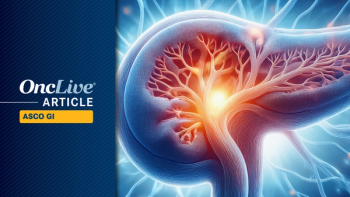
TRK Inhibitors Are a Safe, Effective Option in TRK Fusion-Positive Cancers
Clinical data shows that the TRK inhibitors entrectinib and larotrectinib induce high response rates with favorable toxicity profiles and central nervous system penetration, and are a viable treatment option for patients with advanced TRK fusion-positive cancers.
NTRK fusions in non-small cell lung cancer (NSCLC) are rare, appearing in just 0.23% of tumors, according to Primo Nery Lara Jr, MD, Director of the University of California, Davis Comprehensive Cancer Center. However, clinical data shows that the TRK inhibitors entrectinib (Rozlytrek) and larotrectinib (Vitrakvi) induce high response rates with favorable toxicity profiles and central nervous system (CNS) penetration, and are a viable treatment option for patients with advanced TRK fusion-positive cancers.1
“People with advanced TRK fusion-positive cancers should be offered TRK inhibitor therapy,” said Lara, who also serves as executive associate dean for Cancer Programs and the Codman-Radke Endowed Chair in Cancer Research at UC Davis School of Medicine. He addressed new approaches for TRK-rearranged disease during the 21st Annual International Lung Cancer Congress®.
“Larotrectinib and entrectinib are currently the FDA-approved options because of high response rates, favorable toxicity profiles, and CNS activity,” he added.
Both entrectinib and larotrectinib are FDA-approved tumor-agnostic NTRK inhibitors. Entrectinib is an oral, potent, and selective ROS1/NTRK/ALK tyrosine kinase inhibitor. Larotrectinib is an oral, selective pan-TRK inhibitor for the treatment solid tumors harboring NTRK-fusion proteins.1
In August 2019, the FDA approved entrectinib for adults and children aged 12 and older with NRTK-positive solid tumors without a known acquired resistance mutation that are metastatic or where surgical resection is likely to result in severe morbidity, and that have progressed following treatment or have no satisfactory standard therapy. The agent is also approved for metastatic, ROS1-positive NSCLC.1
De Braud et al presented follow-up data for patients with locally advanced/metastatic ROS1- or NTRK-positive tumors treated with entrectinib in the global phase 1/2 ALKA-372-001 (EudraCT 2012-000148-88), STARTRK-1 (NCT02097810), and STARTRK-2 (NCT02568267) trials. The objective response rate among ROS1-positive patients (n = 53) was 79.2% (95% CI, 65.9-89.2) with 5 complete responses (CRs). For NTRK-positive patients (n = 10), the response rate was 70.0% (95% CI, 34.7-93.3) with 1 CR.2
Lara noted that entrectinib displays strong intracranial activity. Luis G. Paz-Ares, MD, PhD, chief physician at the Hospital Universitario Doce De Octubre, presented an analysis of 53 patients with ROS1-positive NSCLC and 54 patients with NTRK-positive solid tumors at the 2019 World Conference on Lung Cancer.3
The overall response rate (ORR) among NTRK-positive patients with measurable CNS disease was 57.1% and 54.5% among those with measurable and nonmeasurable CNS disease. The ORR for patients with NTRK-positive NSCLC was 66.7%.
In the patients with ROS1-positive NSCLC, the ORR was 75.0% for those with measurable CNS disease and 55.0% among those with measurable and nonmeasurable CNS disease.
Data from a safety review of 68 patients with NTRK fusion-positive tumors presented at the 2018 European Society for Medical Oncology (ESMO) Congress showed that most adverse events (AEs) were grade 1/2, led by dysgeusia (47.1%), constipation (27.9%), fatigue (27.9%), diarrhea (26.5%), peripheral edema (23.5%), and dizziness (23.5%). The most common grade 3 AEs were anemia (11.8%), weight gain (10.3%), and fatigue (7.4%).A similar safety profile emerged from an analysis of the overall safety population (n = 355).4
In November 2018, the FDA granted an accelerated approval to larotrectinib for the treatment of patients with NRTK-positive solid tumors without a known acquired resistance mutation, that are either metastatic or where surgical resection is likely to result in severe morbidity, and who have no satisfactory alternative treatments or whose cancer has progressed following treatment. Larotrectinib was the second tissue-agnostic agent approved for the treatment of cancer following the approval of pembrolizumab (Keytruda) in 2017.1
Investigators presented data from an integrated analysis of the primary and supplementary cohorts treated with larotrectinib in an adult phase 1 trial, the phase 1/2 SCOUT pediatric trial (NCT02637687), and the phase 2 adult/adolescent NAVIGATE basket trial (NCT02576431) at the 2019 ESMO Congress. Larotrectinib induced an ORR of 79% (95% CI, 72-85) in 153 evaluable patients across multiple tumor types, including 24 (16%) CRs. In a subset of 108 patients with confirmed responses, the median duration of response was 35.2 months (95% CI, 22.8-not estimable).5
In an expanded safety cohort of 260 patients, anemia (10%, all grade 3) was most common grade 3/4 treatment-emergent adverse event (TEAE). No other grade 3/4 TEAE occurred in more than 5% of patients.
Treatment-related adverse events (TRAEs) were led by increased alanine transaminase (22%), increased aspartate aminotransferase (20%), dizziness (18%), fatigue (17%), nausea (13%), constipation (11%), and anemia (10%). Grade 3/4 TRAEs were extremely uncommon.
Similar to screening for ROS1, Lara recommended screening for NTRK fusions using a next-generation sequencing (NGS) assay, preferably one that also includes RNA testing. He added that fluorescence in situ hybridization, reverse transcription polymerase chain reaction, or targeted RNA NGS assays with specific probes for the fusion involving the known NTRK gene could be used to confirm the presence of these gene fusions when the histologic tumor type was known to harbor highly recurrent NTRK fusions.1
“From comparisons of sensitivity, specificity, detection of all fusion genes, and appropriateness for primary screening, RNA NGS appears to be the most optimal assay,” Lara added.
References
1. Lara Jr PN. New approaches for TRK-Rearranged Disease. Presented at: 21st Annual International Lung Cancer Congress® hosted by Phyisicans’ Education Resource®, LLC (PER®); July 23-25, 2020; Virtual. Accessed July 23, 2020.
2. De Braud FGM, Siena S, Barlesi F, et al. Entrectinib in locally advanced/metastatic ROS1 and NTRK fusion-positive non-small cell lung cancer (NSCLC): updated integrated analysis of STARTRK-2, STARTRK-1 and ALKA-372-001. Ann Oncol. 2019;30 (suppl_5), v602-v660. 10.1093/annonc/mdz260
3. Paz-Ares L, Dziadziuszko R, Drilon A, et al. Entrectinib in patients with ROS1-positive NSCLC or NTRK fusion-positive solid tumors with CNS metastases. Presented at: 2019 World Conference on Lung Cancer; September 7-10, 2019; Barcelona, Spain. Abst MA14.02.
4. Demetri GD, Paz-Ares L, Farago AF, et al. Efficacy and safety of entrectinib in patients with NTRK fusion-positive tumors: pooled analysis of STARTRK-2, STARTRK-1 and ALKA-372-001. Presented at: 2018 ESMO Congress; October 19-23, 2018; Munich, Germany. Abstract LBA17.
5. Hyman DM, van Tilburg CM, Albert CM, et al. Durability of response with larotrectinib in adult and paediatric patients with TRK fusion cancer. Presented at ESMO Congress 2019; September 27-October 1, 2019; Barcelona, Spain. Poster 445PD.

























































































